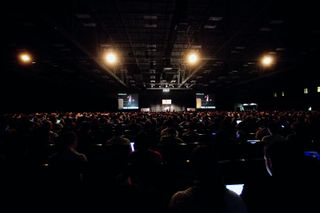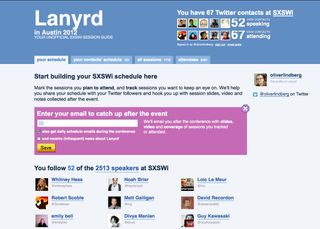How to survive a web conference
It’s time for the web’s best and brightest to come out and play. Gary Marshall discovers how to survive this year’s conference season
Spring has sprung, and that means just one thing: it’s conference season. The enormous, faintly frightening SXSW Interactive kicks things off in Texas in just a week, with the DIBI and Future of Web Design conferences doing their thing in the UK in April and May respectively. Throughout the summer there are events to suit every interest and budget – and, of course, conferences come with a generous helping of after-show parties and networking opportunities.
So, how do you get the best from this year’s conference crop, ensuring you return home with a head full of new ideas and a bulging contacts book instead of a hangover that could stun a horse?
1. Do your homework
The bigger the conference, the more important planning becomes: much like at Glastonbury Festival, you simply can’t see and hear everything that’s happening. Most conferences publish details of keynotes and workshops far in advance. For example, SXSW Interactive (and Lanyrd as well as Sched) publish not just the names of its keynote speakers but
also the dates and times as soon as the speakers are confirmed.
2. Don’t think you can teleport
The venue may be much bigger than it appears on the online map. The Austin Convention Center, home of SXSW, is enormous, and your correspondent has wasted many valuable hours and missed the odd workshop after becoming hopelessly lost in the labyrinthine conference suites of US hotels. So getting from seminar A to workshop B may take more time than you’re expecting.

3. Expect the unexpected
Overly tight planning doesn't leave room for serendipity, and this can be one of the most valuable things about web conferences. Bumping into interesting people or being told about interesting things to see, hear or do can be a crucial part of the whole experience.
4. Be social
Web conferences are, of course, social events – and this means that without social media, you’re missing most of the story. It’s not just about using Twitter to amuse other attendees during keynotes: social media’s role can and should start long before you pack your overnight bag.
A common complaint about web conferences is that they’re all a bit cliquey, with the in-crowd high-fiving one another while lesser mortals are frozen out. There’s a grain of truth to that, but it’s only a grain. In most cases, it’s not that someone looks down on you; it’s that they’ve never spoken to you. Engaging with other attendees via Twitter, Facebook, blogs or forums can ease introductions, and sites such as Lanyrd make it easy to see who’s going to what and who they are on Twitter. If you’re keen to meet someone with a fairly high profile, communicating with them in advance is a very good idea.
Get the Creative Bloq Newsletter
Daily design news, reviews, how-tos and more, as picked by the editors.

5. Stay social
Keep any eye on Twitter as you travel; many use it to warn of cancelled flights. Track hashtags that interest you, and save searches to your phone. Read speakers’ blogs so you know what’s on their minds should you bump into them. Follow fellow attendees on Foursquare, Gowalla or whatever location-based service is that particular week’s New Twitter.
6. Bring cards – lots of them
Business cards are essential – they’re more convenient than sharing data via smartphone apps or any other high-tech solutions – and should ideally be memorable without being annoyingly zany. Consider including a photo so that people can put a face to your name once the conference is over.
7. Look into the logistics
Whether you’re popping down to Portsmouth for Heart & Sole or taking an aeroplane to New Zealand for Webstock, it’s important to cover the travel basics. Early hotel booking is essential and last-minute flight booking is unlikely to end happily. If you’re going to one of the bigger conferences, consider (and research) public transport rather than car rental. Rock star-sized events attract rock star-sized crowds, which can make parking painful.
While we’re on the subject of rock stars, watch out for them too – real ones, that is. Your chosen conference might not seem particularly massive, but if it coincides with a major gig or event, public transport could be packed and taxis hard to find.
8. Think print
Take hard copies of travel documents, hotel bookings and so on – storing them on your phone is a great idea, but what if you lose your phone? Make sure you know exactly where you’re going to be staying, including the address. “The Hilton” could mean the one at the airport, the one downtown or the Canine Hilton boarding kennel.
9. Skip the stilettos
Bring clothes for every eventuality. A typical day could take you from air-conditioned comfort to searing heat (or bitter cold), and from cool venues to hot clubs. Make sure your shoes are up to the job, too, because you’ll be walking a lot.
10. Don’t pack it all!
Choose your kit wisely. Decent point-and-shoot cameras are considerably less clumsy than digital SLRs, while netbooks and MacBook Airs are more portable than traditional laptops. If you need connectivity, consider taking a 3G dongle, because conference Wi-Fi is famous for its inability to cope with large tech crowds. Or just use paper: notebooks are perfect for scribbling bullet points during conferences, and ballpoints don’t run out of batteries.
11. Know the rules
Don’t assume it’s okay to whip out a Flip and film a speaker. You’ll almost certainly need permission to shoot video, and in some cases photography may require permission, too. If in doubt, ask in advance.
12. Listen to your mother
Remember your first music festival and your mum’s advice about drinking lots of water, remembering to eat and pacing yourself? All apply equally well to web conferences. Eating might involve some forward planning. As Sam Eder of Small World Labs stresses: “The places immediately surrounding the conference center fill up fast at regular mealtimes. Either try to eat at off times or walk a little bit to avoid the crush.” He also points out that “big parties = long lines... To avoid standing in an hour-long drink wait, buck the casually late trend and show up early.”
13. Get - and return - attention
Don't forget to work on your elevator pitch. You'll meet a lot of new people, so a succinct, bullshit-free explanation of who you are is essential. Once you’ve got someone’s attention, return it. As David Armano writes: “There is serious internet star power at all levels at SXSW in addition to it presenting all kinds of networking opportunities. This can cause [what] I call Wandering Eye Syndrome, where you’re constantly scanning the crowds for better networking candidates than the one you may currently be engaged with.” You know that guy? Don’t be him.

Thank you for reading 5 articles this month* Join now for unlimited access
Enjoy your first month for just £1 / $1 / €1
*Read 5 free articles per month without a subscription

Join now for unlimited access
Try first month for just £1 / $1 / €1
The Creative Bloq team is made up of a group of design fans, and has changed and evolved since Creative Bloq began back in 2012. The current website team consists of eight full-time members of staff: Editor Georgia Coggan, Deputy Editor Rosie Hilder, Ecommerce Editor Beren Neale, Senior News Editor Daniel Piper, Editor, Digital Art and 3D Ian Dean, Tech Reviews Editor Erlingur Einarsson and Ecommerce Writer Beth Nicholls and Staff Writer Natalie Fear, as well as a roster of freelancers from around the world. The 3D World and ImagineFX magazine teams also pitch in, ensuring that content from 3D World and ImagineFX is represented on Creative Bloq.




